Binance exchange is no longer just an exchange. For a long time, we have been witnessing the provision of various services by this exchange, and we encounter new services in every update.
opBNB is a second layer solution for the BNB smart chain, which has recently been launched as a test network. From the name of this service, we can guess that the developers are very optimistic to launch this network.
This issue is so interesting that we want to scrutinize it more and see what opBNB’s solution is and what Binance’s goal is in setting up this second layer network.
Key points of opBNB
- The opBNB network is the second layer solution of the BNB chain, which is based on Optimism.
- The opBNB solution uses optimistic rollups.
- The purpose of implementing such a solution is to increase the speed of transactions, reduce costs and scalability.
- opBNB does not have a native token and uses the main ecosystem token, BNB.
- opBNB developers have announced that this network does not have airdrop.
In this article we will check out together:
- What is opBNB?
- What was the purpose of creating opBNB?
- How does opBNB work?
- Features of opBNB
- What is the use of opBNB?
- What effect does the opBNB network have on the smart chain of Binance and BNB?
- Advantages and disadvantages of opBNB
- What is the current status of opBNB?
- The difference between opBNB and first layer and second layer networks
- opBNB does not have airdrops
- Frequently asked questions on opBNB
What is opBNB?
opBNB is a second layer solution for the BNB ecosystem, built using the Bedrock version of the OP stack. Since the gas cost in this solution is low and affordable, it can be said that opBNB is a practical method and will have a high chance of public acceptance in the digital currency platform.
Binance hopes that this layer two network will meet different needs in gaming, among decentralized exchanges, and in the world of NFTs, while also having optimal performance. opBNB works on optimistic rollups.
In such a structure, transactions are collected in batches and then executed outside the main chain. This mechanism is based on the fact that all the actors of the network of nodes are honest.
Unless it is proven against this issue, in which case the necessary measures will be taken to catch the violators through proof of fraud.
The capacity of blocks in this system can reach 100 million gas per second, which is much more than other layer two solutions based on the Ethereum platform.
Also, gas fees can reach an average of $0.005 and block time is one second in opBNB. These are the most obvious features by which opBNB can be described.
It allows users to deposit and withdraw funds, use smart contracts and view network data, all while maintaining high throughput and low gas costs.
opBNB seeks to increase scalability and overcome the limitations of the BNB smart chain. If these things are done correctly, opBNB can provide a good experience for users.
This network can now be used as a testnet and therefore its data cannot be argued. Especially since as soon as this network was launched, everyone started talking about opBNB airdrop. However, the BNB chain has denied any airdrop in this regard.
The BNB chain has repeatedly stated clearly in its media that the new services of this ecosystem will not have new tokens and will use the same BNB. So be careful not to fall into the trap of profiteers who spread the promise of opBNB airdrop everywhere.
What was the purpose of creating opBNB?
Implementation of a platform for transactions with high capacity and low gas costs has been the entire focus and goal of opBNB. If we want to have a general look at the goals of opBNB, we should mention the following points:
- Increase operational capacity
- Improved scalability
- Cost efficiency
- compatibility
- security
- flexibility
- Interchain collaboration
- Data availability
- Participation of community members
In the following sections and in the explanations, we will talk more about these things and find out how this network reaches these goals.
How does opBNB work?
Since opBNB is a layer two solution, it processes transactions outside the main chain and publishes data on the main network like its other counterparts.
Users deposit their assets through BSC and use the programs and contracts based on opBNB. In this system, we have several actors who each have important duties and manage this chain together. These actors are as follows:
- Sequencer: Sequencers aggregate transactions and calculate the status of transfers. They are then provided to BNB smart chain rollup contracts.
- Prover: The work of provers is to produce encrypted proofs. The application of these certificates appears in the validation and confirmation of transfer modes.
- Verfier: Finally, it is the verfiers who check the credentials to confirm that the opBNB status is correct.
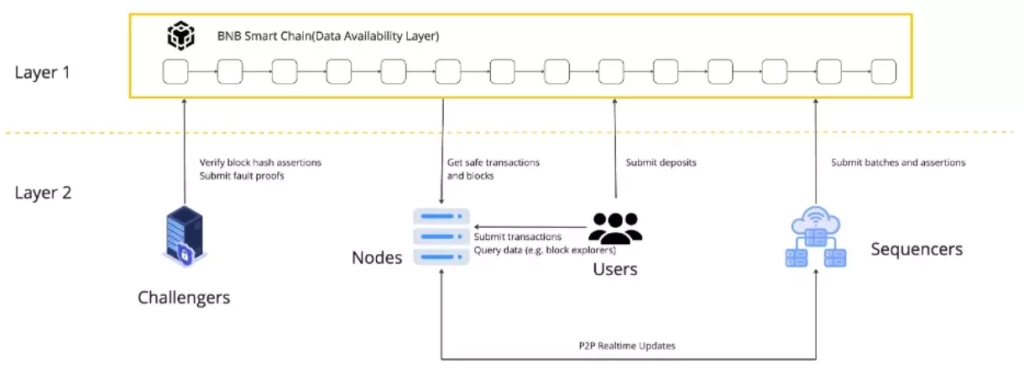
We said above that opBNB uses optimistic rollup. This solution also uses Ethereum Virtual Machine (EVM).
This means that decentralized applications can migrate to Ethereum networks, BNB smart chain, Polygon and other Ethereum virtual machine compatible chains, without the need for major changes in their codes. This increases flexibility and adaptability.
Features of opBNB
Some of the key features of this layer two network can be expressed as follows:
- opBNB is an optimistic rollup. Therefore, the smart chain scales BNB by collecting transactions off-chain and ensures their authenticity by using fraud proofs. This feature provides higher throughput for opBNB.
- opBNB uses Ethereum virtual machine. This increases cross-chain flexibility and interoperability, which is a plus.
- Decentralized applications and smart contracts can migrate from opBNB to any Ethereum virtual machine compatible chain such as BNB or Polygon smart chain.
- It doesn’t cost much to build apps on opBNB.
- This solution derives its security from the BNB smart chain.
- opBNB is fully compatible with the BNB ecosystem.
- The opBNB layer two solution is based on the native BNB token.
What is the use of opBNB?
The use of opBNB is quite clear. The mission of layer two solutions is to increase scalability.
In the case of opBNB, this application can be seen in a bolder way along with things such as increasing operational capacity and reducing gas costs. In the tables that you will see in the next sections, you can compare the difference between opBNB and other layer two solutions.
Networks such as Ethereum, Polygon, or the same BNB smart chain cannot manage high-volume transactions and face problems if the number of daily active users increases.
In such a situation, the presence of a second layer solution like opBNB can help the BNB smart chain. If the number of BNB chain users increases, the existence of such a solution can be very helpful to keep this ecosystem alive and dynamic.
What effect does the opBNB network have on the smart chain of Binance and BNB?
Now that our discussion has reached here and we have examined opBNB from several perspectives, we can address an important issue. What is the effect of setting up such a network on BSC?
It is widely talked about that opBNB can dramatically increase the performance and scalability of the BNB smart chain. The official website of opBNB has also mentioned that the transfer speed in the test network is on average more than 4 thousand transactions per second and the average fees are 0.005 dollars.
On the other hand, Binance is increasing its power and dominance in various aspects. This issue can cause more acceptance of BNB among people and as a result increase the price of this cryptocurrency.
It is not unreasonable to say that the BNB ecosystem and the users who operate in this network can benefit from the side and direct benefits of opBNB.
In particular, by launching these services, Binance increases the use of its native token and encourages users to use BNB more.
Advantages and disadvantages of opBNB
Let’s go to the pros and cons of opBNB to better understand the strengths and weaknesses of this solution. Of course, we reviewed most of the benefits in the features section, and now we mention a few more:
- Integration with the BNB ecosystem due to the benefits of BNB Greenfield, which provides cost-effective, secure and scalable solutions (BNB Greenfield is a new service of the BNB chain, which is a storage platform for providing decentralized data ownership services).
- Security due to the use of configurators, validators and verifiers that ensure the security of transactions and state transfers.
- Flexibility and decentralization due to the use of the OP stack, which provides a changeable and modular design and makes opBNB not dependent on a single implementation and interacts with the Blockchain network in various ways.
- Ability to work with other layer two platforms compatible with Ethereum and Solidity virtual machine.
- opBNB shows the problem of data availability (DA for short) by separating the DA layer from the execution layer, and this makes it possible to choose different data access options. This makes it possible to switch between different DA schemes based on performance and security needs.
- The participation of community members regarding the launch of the opBNB test net, which makes users refer to this test network and give feedback.
Since the opBNB main net is not yet launched, it is not possible to know much about its disadvantages. The life of the test network is not long and it is not possible to know how long the acceptance of this solution will continue in the long term.
It is natural that now, at the beginning of the launch, some people use this network out of curiosity and some just to receive a possible airdrop.
What is the current status of opBNB?
Currently, opBNB started its work as a test network on June 19 and according to the roadmap that has been planned for it, its main network is also supposed to be launched in 2023.
It should be mentioned that due to the rumors about the potential airdrop of this network, many users have switched to the test network and are busy bridging, depositing and withdrawing on this network.
The difference between opBNB and first layer and second layer networks
To understand a service or solution, it is always easier to compare with other competitors. So let’s compare opBNB with two other layer 2 solutions namely Optimism and Arbitrum and see which one will win this field.
| Parameter | opBNB | optimism | Ethereum |
| Gas limit in the block | 100 million gas | 30 million gas | 30 million gas |
| Gas target in the block | 50 million gas | 5 million gas | 15 million gas |
| Gas shift coefficient in EIP-1559 | 2 | 6 | 2 |
| Gas division number in EIP-1559 | 8 | 50 | 8 |
| The biggest increase in base fee per block | 12.5% | 10% | 12.5% |
| The biggest increase in base fee per block | 12.5% | 2% | 12.5% |
In the table below, we have compared the second layer solutions based on different criteria:
| Parameter | opBNB | optimism | Arbitrum |
| The token with which gas is paid | BNB | ETH | ETH |
| virtual machine | EVM | EVM | EVM |
| Gas fee | $0.005 | $0.005 | $0.1 |
| Gas limit in the block | 100 million | 30 million | 32 million |
| block time | 1s | 2s | 0.25s |
| Finality/ withdrawal | 7 days | 7 days | 7 days |
| TPS | over 4500 | over 700 | over 4000 |
These data show that opBNB has a lower gas fee and a higher gas limit per block compared to other layer two solutions based on Ethereum such as Arbitrom and Optimism. This factor makes Gas Fee less fluctuating when layer 2 traffic increases.
It is not bad to have a comparison between this network and layer one. See the table below:
| Parameter | opBNB | BSC | Ethereum |
| The token with which gas is paid | BNB | BNB | ETH |
| virtual machine | EVM | EVM | EVM |
| Gas fee calculation model | EIP-1559 | gas auction | EIP-1559 |
| Gas limit in the block | 100 million | 140 million | 30 million |
| block time | 1s | 3s | 12s |
| Transaction fee | $0.005 | $0.03 | $1 |
opBNB does not have airdrops
It has been a while since the start of test networks, airdrop has been heard everywhere. When the opBNB test network was launched, news about the possible airdrop of this layer two solution was circulating on Twitter and other virtual networks.
Although the dev team has clearly stated on Twitter that there is no news of opBNB airdrops, we still want to walk through a few steps of working with this test network.
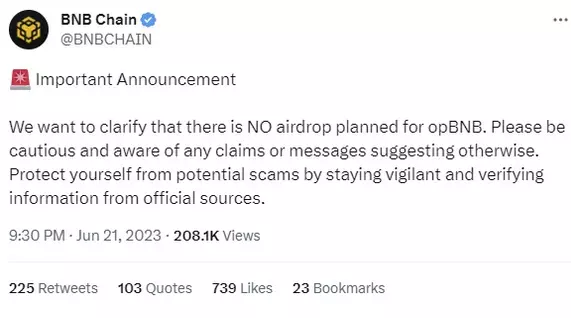
First step: receiving the faucet
To receive a test token, visit this link and enter your wallet address in the relevant box. Then click the Give me BNB button to deposit 0.1 BNB test token into your wallet. You can also click on this link, of course, to receive faucet in this way, you must have 0.001 Ether on the Ethereum main network.
Second step: bridging
Now we need to bridge from BNB Smart Chain Testnet to opBNB testnet. For this, visit this address and connect your wallet.
In the box that is displayed to you, in the Deposit tab, deposit the desired amount and confirm the transaction. Do this by selecting the Deposit button.
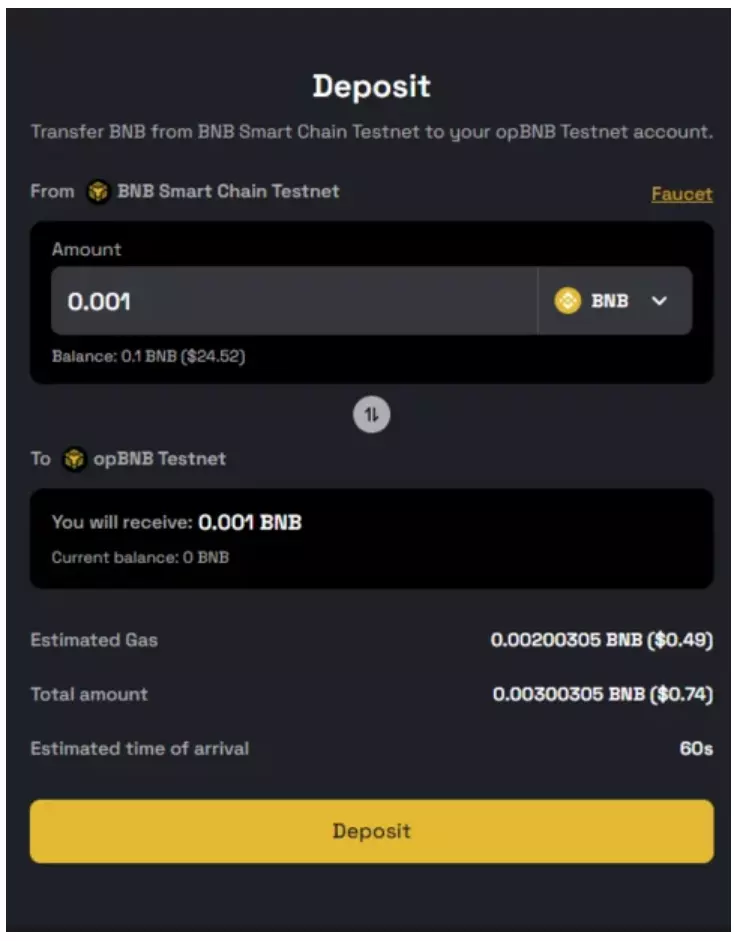
Then confirm the transaction in your wallet. After a successful transaction, check the history and make sure that the status of this transaction is Completed.
Third step: withdrawal
To withdraw assets, go to the Withdraw tab. Change the network to opBNB Testnet. Finally, write the desired amount you want to withdraw and click on the Withdraw option.
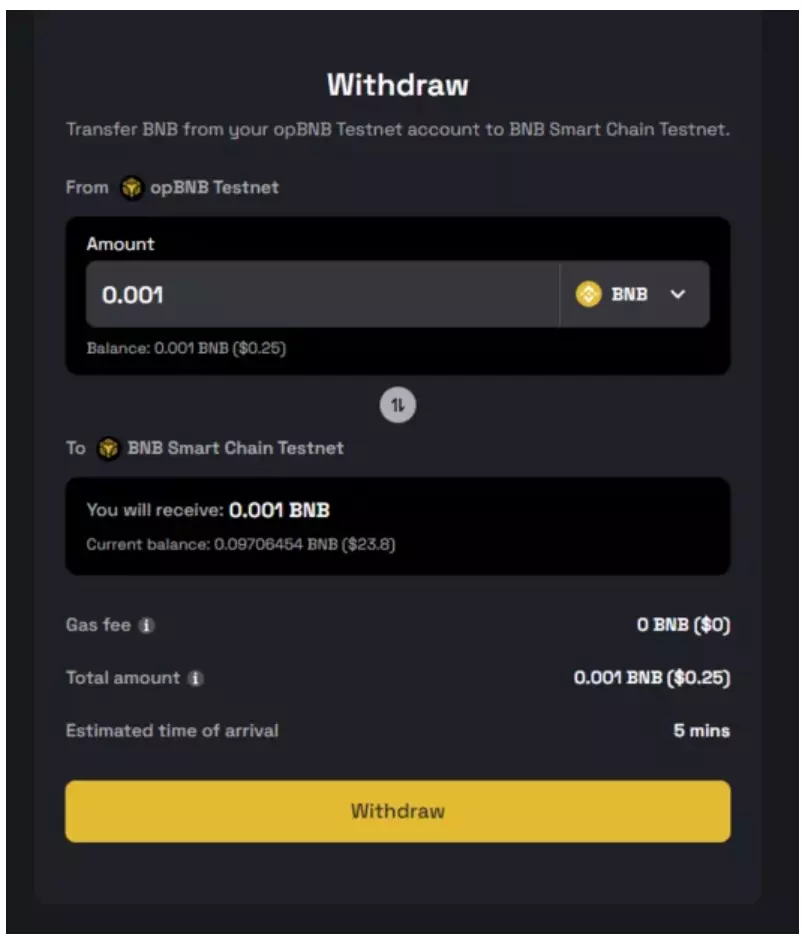
Wait and see the message to confirm the transaction in your wallet. Now you will see a message on the screen that your transaction has been registered. Again, through the history tab, you can review your actions.
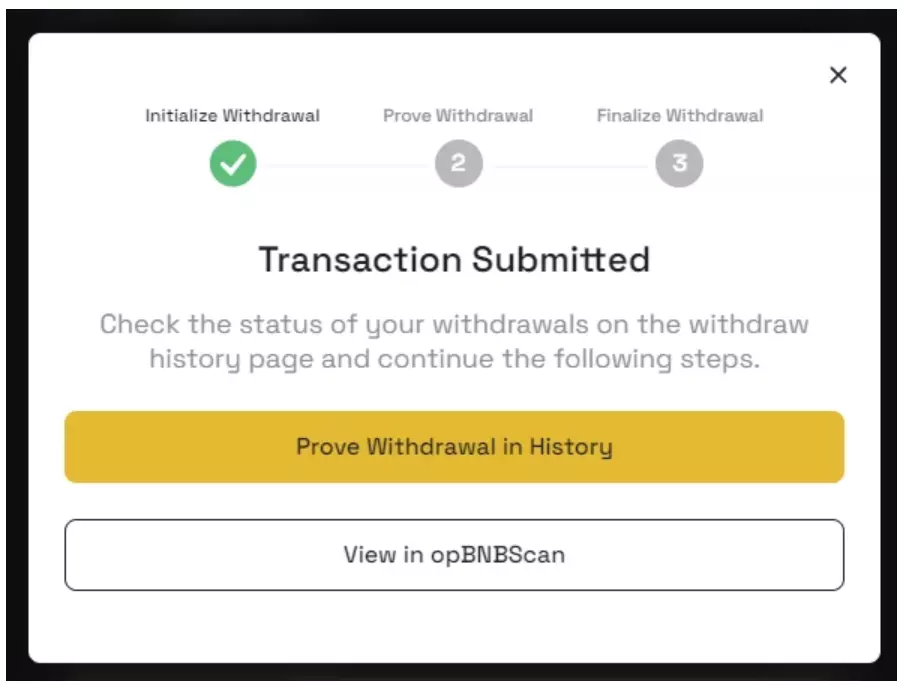
It will take a few minutes to finalize the withdrawal. You can see the status of your transaction through the Withdrawals tab. In the image below, the payment status is “Waiting for Verification”.

After some time, this phrase will change to Prove Withdrawal, by clicking on which you need to confirm the message seen in the wallet. After doing these things, you will see that the section below the Prove Transaction column is also completed.
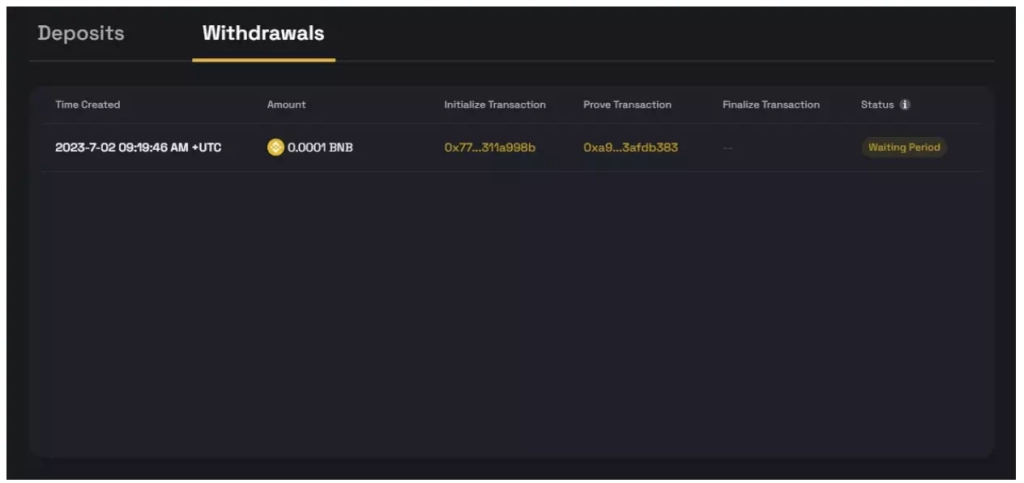
Wait again and after some time click on Finalize Withdrawal option to finalize the transaction.
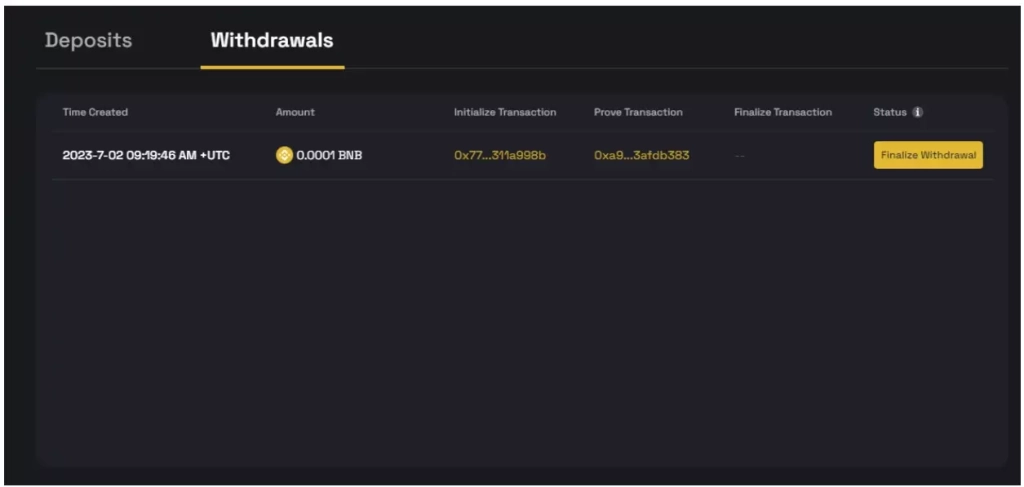
With this, you need to confirm in your wallet until you finally see an image like the one below
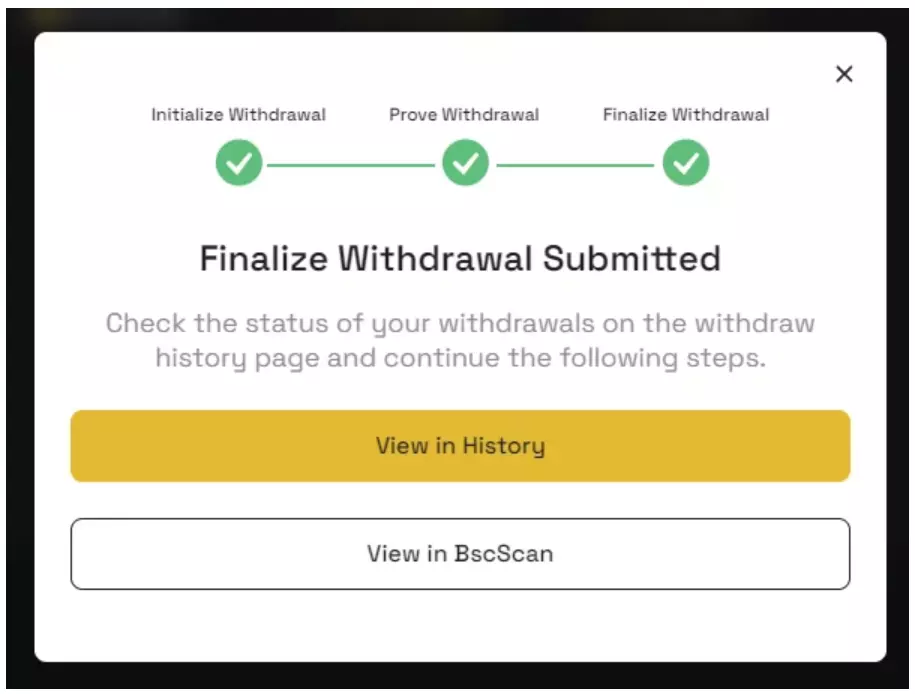
Finally, when you return to History, you will see that your transaction status has changed to Completed.
Frequently asked questions on opBNB
What is the opBNB network?
The second layer solution is dedicated to the BNB smart chain, which is based on the Bedrock version of the OP stack and works with the help of optimistic rollups.
Does the opBNB network have a native token?
no This network uses the Binance ecosystem token, BNB.
Does opBNB have airdrop?
The opBNB developers have stated that the network has no plans for airdrops.
Binance exchange has created a wide ecosystem and unveils new services in its updates. The BNB smart chain has recently launched its second layer solution called opBNB, which relies on optimistic rollups and operates on the bedrock platform of the optimism stack.
This network, like all layer two solutions, wants to increase scalability. By comparing opBNB with other layer two networks, we saw that this new solution can enable transactions with lower fees and faster speed. The developers of this network have announced that they do not intend to offer airdrops, but the news of opBNB airdrops has spread everywhere.
Regardless of whether this network has airdrop or not, it is not bad to work with its test net and if there is a possibility to receive airdrop, don’t miss your chance.
What do you think is the importance of the opBNB network? Why did Binance launch such a network? Is this exchange just looking for competition or does it want to increase the value of the BNB token in this way?


